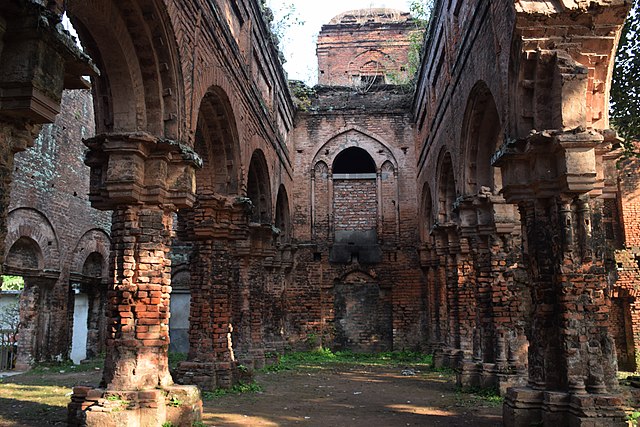Tamluk
Town in West Bengal, India From Wikipedia, the free encyclopedia
Town in West Bengal, India From Wikipedia, the free encyclopedia
Tamluk (/ˈtæmlʊk/) is a town and a municipality in the Indian state of West Bengal. It is the headquarters of the Purba Medinipur district. Though there is some controversy, scholars have generally agreed that present-day Tamluk is the site of the ancient city variously known as Tamralipta or Tamralipti, where Hien Chang, a Chinese traveller, visited the town, is now located on the banks of Rupnarayan River, close to the Bay of Bengal.
Tamluk
Tamralipta, Tamralipti, Tamolika | |
|---|---|
City | |
 Bargabhima temple at Tamluk | |
| Coordinates: 22.3°N 87.92°E | |
| Country | |
| State | |
| District | Purba Medinipur |
| Government | |
| • Type | Municipality |
| • Body |
|
| Area | |
| • Total | 17.86 km2 (6.90 sq mi) |
| Elevation | 7 m (23 ft) |
| Population (2011)[2] | |
| • Total | 65,306 |
| • Density | 3,700/km2 (9,500/sq mi) |
| Languages | |
| • Official | Bengali[3][4] |
| • Additional official | English[3] |
| Time zone | UTC+5:30 (IST) |
| PIN | 721636 721627 721648 721649 |
| Telephone code | 91-3228 |
| Vehicle registration | WB 29-xxxx, WB 30-xxxx |
| Lok Sabha constituency | Tamluk |
| Vidhan Sabha constituency | Tamluk |
| Website | purbamedinipur |


According to T. N. Ramachandran, the name "Tamluk" is related to the older form Tamālikā, which is a variant spelling (found in the Trikāṇḍaśesha) of the ancient name Tāmraliptī (or Tāmralipta). Other names listed in the Trikāṇḍaśesha and the Abhidānachintāmaṇi as referring to Tāmraliptī include Staṁbhapura, Velākūla, and Vishṇugṛiha.[5]: 229
This ancient kingdom and port city was bounded by the Bay of Bengal in the south, Rupnarayan River in the east and Subarnarekha River in the west. The Rupnarayana is the joint flow of the rivers Dwarakeswar and Silai. The Bay of Bengal and these great rivers with their numerous branches created a prosperous and easy water navigational system fostering commerce, culture and early contacts with the people outside the region. At the same time, these rivers helped to develop the agriculture in this region.[6]
Archaeological remains show continuous settlement from about the 3rd century BC. It was known as Tramralipta (in the Puranas and the Mahabharata), Tamralipta (in the Mahabharata), Tamalika (in historical documents), Tamalitti (in foreigners' descriptions), or Tamoluk (in the British Raj). It was a seaport, now buried under river silt. For this reason, Tamluk has many ponds and lakes remaining today.[7][8][9]
In the Mahabharata (Bhishma Parba/Nabam Adhyay), while describing the names of the holiest rivers and kingdoms of India, Sanjay took the name of "Tramralipta" to Dhritarashtra.[10][11][6]
Tamluk was also known as Bhivas, in religious texts, and Madhya Desh, as the Middle State of Utkal/Kalinga and Banga.[citation needed]
According to Jain sources, Tamralipti was the capital of the tamralipti janapada and was long known as a port.[12][13][5][14]
Several archaeological find sites have been found in Tamluk, including a number of high mounds in the town as well as in and around various tanks. The Bargabhīmā Temple, in the middle of town, is built on one such mound.[15] Another mound is now occupied by the local Mission house. Here, people digging a well found wood fragments at a depth of 50 feet, which T. N. Ramachandran compared to the remains of the Maurya-era wooden palisade found at Pataliputra. At another high mound, this one by the Rupnarayan riverbank, a hoard of about 350 coins dated to the 1st-2nd centuries BCE was found by K. N. Dikshit in the early 1920s.[5]: 230–2
Just east of the Rajbari in central Tamluk is a large square tank called Khātpukūr, which probably dates from the 15th century. Digging here, Ramachandran's group found terracotta remains with similarities to Shunga-period artifacts, but because of where they were found, Ramachandran did not assign them a date. Among the artifacts found at Khātpukūr were a couple of Egyptian-style vases, which also could not be dated. They may have been either imports from Egypt or local imitations of Egyptian style. Either way, their presence indicates long-distance cultural contact due to maritime trade, as would be expected at a major port like Tāmraliptī. At another site, "an oblong tank next to the local school", old brick walls and terracotta fragments were found under Gurusday Dutt. Various items were found in and around a couple of tanks on Adhikaripara Road, Padambasan Road, and School Road.[5]: 230, 235–7
A group led by T. N. Ramachandran undertook a survey of various sites in Tamluk in the 1940s.[5]: 229–30

Tamluk is located on the right bank of the Rupnarayan river, about 19 km upstream from where it joins the Hooghly River.[5]: 226

Tamluk police station has jurisdiction over Tamluk (municipality) and Tamluk CD Block. Tamluk police station covers an area of 214.14 km2 with a population of 352,748.[16][17]
According to 2011 Indian Census, Tamluk had a total population of 65,306, of which 33,260 were males and 32,046 were females. Population within the age group of 0 to 6 years was 6,180. The total number of literates in Tamluk was 53,318, which constituted 81.6% of the population with male literacy of 85.0% and female literacy of 78.1%. The effective literacy rate of population (7 years and above) of Tamluk was 90.2%, of which male literacy rate was 94.0% and female literacy rate was 86.2%. The Scheduled Castes and Scheduled Tribes population was 4,441 and 201 respectively. Tamluk had 14489 households in 2011.[2]
Tamluk has two railway stations - Tamluk Junction and Sahid Matangini.


Seamless Wikipedia browsing. On steroids.
Every time you click a link to Wikipedia, Wiktionary or Wikiquote in your browser's search results, it will show the modern Wikiwand interface.
Wikiwand extension is a five stars, simple, with minimum permission required to keep your browsing private, safe and transparent.